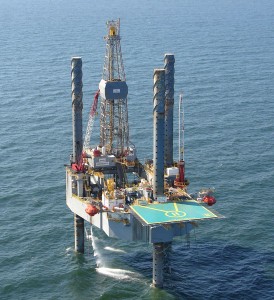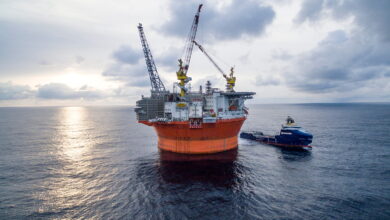Approval delays, dispute on flow calculations stall shallow-water drilling permits
 The staff of the Bureau of Ocean Energy Management, Regulation and Enforcement (BOEM) is being strained to the breaking point in processing applications under new government rules, a study by the Shallow Water Energy Security Coalition (SWESC) and the Gulf Economic Survival Team (GEST) found. SWESC comprises IADC members owning and operating the bulk of jackups in the Gulf of Mexico.
The staff of the Bureau of Ocean Energy Management, Regulation and Enforcement (BOEM) is being strained to the breaking point in processing applications under new government rules, a study by the Shallow Water Energy Security Coalition (SWESC) and the Gulf Economic Survival Team (GEST) found. SWESC comprises IADC members owning and operating the bulk of jackups in the Gulf of Mexico.
The study reviewed data from BOEM records regarding plans submitted under BOEM’s Notice to Lessees 2010-N06 and polled more than 20 operators. The findings revealed that BOEM already has under review 44 exploration or development plans involving new drilling activity, along with another 14 previously approved exploration or development plans that require submission of NTL N06 data. NTL N06, issued on 18 June, instructs operators on what information they must submit for worst-case discharge scenarios in case of a blowout. NTL N06 is the second of two NTLs issued in the wake of the Macondo blowout.
Further, the operator poll revealed that an additional 69 exploration or development plans will be submitted in the next 60 days.
Senior BOEM officials have told Jim Noe, Senior Vice President for Hercules Offshore Inc, that each data submission under NTL N06 requires 150 manhours to process.
Mr Noe, a leader in SWESC, did the math: “It will require 19,050 manhours for BOEM just to process the new data,” he said. “Obviously, we will be waiting a long time for the BOEM to allow new wells to go forward, unless the agency finds some way of streamlining the review process.”
NTL 2010-N05, the first BOEM notice, deals with BOP certification and other equipment issues. The industry responded robustly to this requirement. By late August, 107 permits were approved under NTL N05 for water depths of 500 ft or less, and 36 for deeper water, according to the BOEM website.
“We got that done post haste,” remarked John Rynd, CEO of Hercules Offshore and an SWESC leader. Mr Rynd is a member of the IADC executive committee. He will address a joint luncheon meeting of the Houston IADC and AADE Chapters on 2 September at the Houston Petroleum Club. To register, call +1 936 856 4071 or email gloriacall@suddenlink.net.
However, only four permits have been approved under NTL N06 as of 31 Aug. “NTL N06 is the one that has everything grinding to a halt,” Mr Rynd said.
While NTL N06 sets forth no new requirements, it details what information must be supplied. And here exists an impasse between BOEM and operators. Mr Noe explained that BOEM first insisted that operators use the absolute open flow rate as the worst case discharge figure in their exploration plans and drilling permit applications.
Operators, however, point out that geologic conditions must also be considered, including known reservoir characteristics, the presence of sand or rock barriers, analog reservoir information, production date from nearby wells and the propensity of many wells to “bridge” themselves over and naturally stop the flow in a well control event.
Meanwhile, the number of idled rigs continues to swell. By the end of August, 26 of the 46 available jackups in the Gulf of Mexico will be awaiting government permits, according to SWESC. By the end of September and October, absent new permits, the idle-rig fleet will expand to 28 and 37, respectively.
Workovers and sidetracks, which can continue, may mitigate this somewhat. However, without drilling, the offshore employment picture is grim. While shallow-water drillers have kept hundreds of workers on the payroll on idled rigs, hoping that BOEM would begin issuing permits promptly, this is unlikely to be sustainable indefinitely.
“The brick wall is coming,” said Mr Rynd.





Asking an operator for a “worst case discharge scenario in the event of a blowout” (especially without being allowed to included geological factors or offset info) is like asking an airline “If one of your airplanes crashes into the main terminal building at DFW or Atlanta, what are the worst possible estimates of deaths and property loss?”
No matter what you get for an answer, it’s pretty speculative.
What they should be worrrying about instead is: “What safegaurds and redundancies have you built into your well design and/or equipment have you added to your rig to prevent a blowout in the first place?”
It’s worse than a cart before the horse mentality, it’s a cart WITHOUT a horse mentality.
We are, however, talking about politicians and bureaucrats, so that’s probably to be expected.
As mentioned in the article, drilling contractors are only going to keep the people sitting on the rigs (hot stacked) for a limited amount of time before the massive layoffs begin. And we KNOW (from the last couple of cycles) that once you lay off all the hands and downsize they find jobs in other fields of endeavor and it’s a slow and painful (multi-year) process to ramp up again.
AND, we also know that safety suffers accordingly (because you have a bunch of inexperienced people out there) and you have more frequent accidents.
Since the whole goal is SUPPOSED to be making things safer and reducing accidents, the path that the politicians and bureaucrats are headed down is 180 deg the WRONG direction because it is going to make things worse, not better.